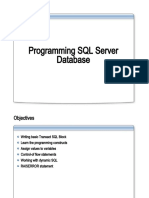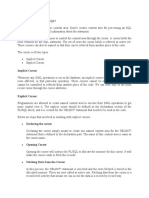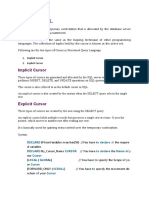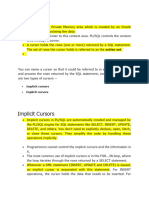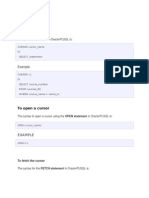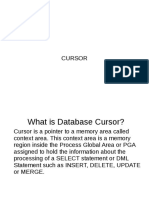Cursors - TSQL Tutorial: Declare Cursor Syntax
Uploaded by
CeLs GaCursors - TSQL Tutorial: Declare Cursor Syntax
Uploaded by
CeLs GaCursors - TSQL Tutorial
In this chapter you can learn how to work with cursors using operations like declare
cursor, create procedure, fetch, delete, update, close, set, deallocate.
Cursor operations
Declare cursor
Create procedure
Open cursor
Close cursor
Fetch cursor
Deallocate cursor
Delete
Update
Declare cursors
Declare cursor Syntax:
DECLARE cursor_name CURSOR [ LOCAL | GLOBAL ]
[ FORWARD_ONLY | SCROLL ]
[ STATIC | KEYSET | DYNAMIC | FAST_FORWARD ]
[ READ_ONLY | SCROLL_LOCKS | OPTIMISTIC ]
[ TYPE_WARNING ]
FOR select_query_statement
[ FOR UPDATE [ OF column_name [ ,...n ] ] ] ;
Declare simple cursor example:
DECLARE product_cursor CURSOR
FOR SELECT * FROM model.dbo.products;
OPEN product_cursor
FETCH NEXT FROM product_cursor;
Create procedure
Create procedure example:
USE model;
GO
IF OBJECT_ID ( 'dbo.productProc', 'P' ) IS NOT NULL
DROP PROCEDURE dbo.productProc;
GO
CREATE PROCEDURE dbo.productProc
@varCursor CURSOR VARYING OUTPUT
AS
SET NOCOUNT ON;
SET @varCursor = CURSOR
FORWARD_ONLY STATIC FOR
SELECT product_id, product_name
FROM dbo.products;
OPEN @varCursor;
GO
Open cursors
Open cursor Syntax:
OPEN { { cursor_name } | cursor_variable_name }
Open cursor example:
USE model;
GO
DECLARE Student_Cursor CURSOR FOR
SELECT id, first_name, last_name, country
FROM dbo.students WHERE country != 'US';
OPEN Student_Cursor;
FETCH NEXT FROM Student_Cursor;
WHILE @@FETCH_STATUS = 0
BEGIN
FETCH NEXT FROM Student_Cursor;
END;
CLOSE Student_Cursor;
DEALLOCATE Student_Cursor;
GO
Close cursors
Close cursor Syntax:
CLOSE { { cursor_name } | cursor_variable_name }
Close cursor example:
USE model;
GO
DECLARE Student_Cursor CURSOR FOR
SELECT ID, FIRST_NAME FROM dbo.students;
OPEN Student_Cursor;
FETCH NEXT FROM Student_Cursor;
WHILE @@FETCH_STATUS = 0
BEGIN
FETCH NEXT FROM Student_Cursor;
END;
CLOSE Student_Cursor;
DEALLOCATE Student_Cursor;
GO
Fetch cursors
Fetch cursor Syntax:
FETCH
[ NEXT | PRIOR | FIRST | LAST
| ABSOLUTE { n | @nvar }
| RELATIVE { n | @nvar }
]
FROM
{ { cursor_name } | @cursor_variable_name }
[ INTO @variable_name [ ,...n ] ] ;
Fetch in cursors example:
USE model;
GO
DECLARE Student_Cursor CURSOR FOR
SELECT id, first_name, last_name, country
FROM dbo.students WHERE country = 'US';
OPEN Student_Cursor;
FETCH NEXT FROM Student_Cursor;
WHILE @@FETCH_STATUS = 0
BEGIN
FETCH NEXT FROM Student_Cursor;
END;
CLOSE Student_Cursor;
DEALLOCATE Student_Cursor;
GO
Deallocate cursors
When the cursor is deallocated, the data structures comprising the cursor are released by
Microsoft SQL Server.
Deallocate cursor Syntax:
DEALLOCATE { { cursor_name } | cursor_variable_name }
Deallocate cursor example:
USE model;
GO
DECLARE @CursorName CURSOR
SET @CursorName = CURSOR LOCAL SCROLL FOR
SELECT * FROM dbo.students;
DEALLOCATE @CursorName;
SET @CursorName = CURSOR LOCAL SCROLL FOR
SELECT * FROM dbo.students;
GO
Delete in cursors
Delete in cursors example:
USE model;
GO
DECLARE MyCursor CURSOR FOR
SELECT *
FROM dbo.students
WHERE first_name = 'David' AND last_name = 'BROWN' AND id = 6 ;
OPEN MyCursor;
FETCH FROM MyCursor;
DELETE FROM dbo.students WHERE CURRENT OF MyCursor;
CLOSE MyCursor;
DEALLOCATE MyCursor;
GO
Update in cursors
Update in cursors example:
USE model;
GO
DECLARE test_cursor CURSOR LOCAL FOR
SELECT id, first_name, last_name, section
FROM dbo.students WHERE id = 2;
OPEN test_cursor;
FETCH test_cursor;
UPDATE dbo.students
SET section = 'Medicine'
FROM dbo.students
WHERE CURRENT OF test_cursor;
GO
SELECT id, first_name, last_name, section FROM dbo.students;
GO
Resources:
www.tsql.info/
www.tsql.info/cursors/cursors.php
You might also like
- McKinsey & Company - BU Strategic Plan Template Book - 2001No ratings yetMcKinsey & Company - BU Strategic Plan Template Book - 200158 pages
- What Is Cursor? Define Different Type of Cursor?No ratings yetWhat Is Cursor? Define Different Type of Cursor?2 pages
- Using SQL Server Cursors: General ConceptsNo ratings yetUsing SQL Server Cursors: General Concepts6 pages
- Database Programmin - Cursors Triggers and Stored ProceduresNo ratings yetDatabase Programmin - Cursors Triggers and Stored Procedures40 pages
- Cursors: How To Step Through The Returned Set of RowsNo ratings yetCursors: How To Step Through The Returned Set of Rows12 pages
- Using The Multiple-Row FETCH Statement: Step 1:declare A CursorNo ratings yetUsing The Multiple-Row FETCH Statement: Step 1:declare A Cursor5 pages
- Java Programming Tutorial With Screen Shots & Many Code ExampleFrom EverandJava Programming Tutorial With Screen Shots & Many Code ExampleNo ratings yet
- Drying Wet Framing JLC June 2013 ArticleNo ratings yetDrying Wet Framing JLC June 2013 Article5 pages
- Systems Analysis and Design in a Changing World 7th Edition Satzinger Solutions Manual - Free Download Available To Read All Chapters100% (1)Systems Analysis and Design in a Changing World 7th Edition Satzinger Solutions Manual - Free Download Available To Read All Chapters24 pages
- Introduction To Systems Analysis and DesignNo ratings yetIntroduction To Systems Analysis and Design47 pages
- Bharti Airtel Limited Performance AppraisalNo ratings yetBharti Airtel Limited Performance Appraisal13 pages
- CSE3009 - PARALLEL-AND-DISTRIBUTED-COMPUTING - LTP - 1.0 - 8 - Parallel and Distributed ComputingNo ratings yetCSE3009 - PARALLEL-AND-DISTRIBUTED-COMPUTING - LTP - 1.0 - 8 - Parallel and Distributed Computing2 pages
- Assignment On - KANBAN, INCREASING OVERALL EQUIPMENT EFFICTIVENESS OF PLASMA CUTTING MACHINE AND STUDY OF WELDING PROCESSES.No ratings yetAssignment On - KANBAN, INCREASING OVERALL EQUIPMENT EFFICTIVENESS OF PLASMA CUTTING MACHINE AND STUDY OF WELDING PROCESSES.102 pages
- McKinsey & Company - BU Strategic Plan Template Book - 2001McKinsey & Company - BU Strategic Plan Template Book - 2001
- Database Programmin - Cursors Triggers and Stored ProceduresDatabase Programmin - Cursors Triggers and Stored Procedures
- Cursors: How To Step Through The Returned Set of RowsCursors: How To Step Through The Returned Set of Rows
- Using The Multiple-Row FETCH Statement: Step 1:declare A CursorUsing The Multiple-Row FETCH Statement: Step 1:declare A Cursor
- Java Programming Tutorial With Screen Shots & Many Code ExampleFrom EverandJava Programming Tutorial With Screen Shots & Many Code Example
- Systems Analysis and Design in a Changing World 7th Edition Satzinger Solutions Manual - Free Download Available To Read All ChaptersSystems Analysis and Design in a Changing World 7th Edition Satzinger Solutions Manual - Free Download Available To Read All Chapters
- CSE3009 - PARALLEL-AND-DISTRIBUTED-COMPUTING - LTP - 1.0 - 8 - Parallel and Distributed ComputingCSE3009 - PARALLEL-AND-DISTRIBUTED-COMPUTING - LTP - 1.0 - 8 - Parallel and Distributed Computing
- Assignment On - KANBAN, INCREASING OVERALL EQUIPMENT EFFICTIVENESS OF PLASMA CUTTING MACHINE AND STUDY OF WELDING PROCESSES.Assignment On - KANBAN, INCREASING OVERALL EQUIPMENT EFFICTIVENESS OF PLASMA CUTTING MACHINE AND STUDY OF WELDING PROCESSES.













